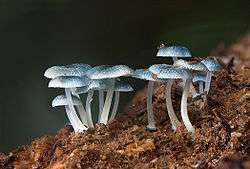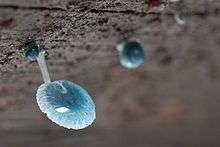Mycena interrupta
Mycena interrupta, commonly known as the pixie's parasol, is a species of mushroom. It has a Gondwanan distribution pattern, being found in Australia, New Zealand, New Caledonia [1] and Chile.[2] In Australia it is found in Victoria, Tasmania, New South Wales, and South Australia,[3] and in Queensland where its distribution is limited to Lamington National Park.[4]
| Mycena interrupta | |
|---|---|
 | |
| Scientific classification | |
| Kingdom: | |
| Division: | |
| Class: | |
| Order: | |
| Family: | |
| Genus: | |
| Species: | M. interrupta |
| Binomial name | |
| Mycena interrupta | |
| Synonyms | |
|
Agaricus interruptus Berk. (1860) | |
Description
The caps of Mycena interrupta range from 0.8 to 2 cm, and they are a brilliant cyan blue colour. They are globose when emergent and then become a broad convex as they mature, with the centre of the cap slightly depressed. The caps are often sticky and appear slimy looking, particularly in moist weather.
The length of the stipe typically ranges from 1 to 2 cm long and 0.1 to 0.2 cm thick. It is white, smooth and the base of the stipe is attached to the wood substrate by a flat white disk, similar to Mycena austrororida, which, unlike M. interrupta is attached to the wood substrate by a mass of clumped fine hairs.
The gills are white, adnexed, with blue margins. The spores are white, smooth, ellipsoid and have dimensions of 7-10×4-6 µm.
Unlike some other Mycena species, Mycena interrupta is not bioluminescent.[5]
Habitat and Distribution
The pixie's parasol appears in small colonies on rotting, moist wood in rainforests and beech or eucalypt forests. It has a Gondwanan distribution.

References
| Wikimedia Commons has media related to Mycena interrupta. |
- "Mycogeography - Australia's Gondwanan and Asian connections". Anbg.gov.au. 2011-06-23. Retrieved 2012-01-25.
- "Mycena interrupta". Biology-blog.com. Archived from the original on 2012-02-24. Retrieved 2012-01-25.
- "Archived copy". Archived from the original on 2014-11-29. Retrieved 2014-04-13.CS1 maint: archived copy as title (link)
- A field guide to the fungi of Australia. By Tony Young, A. M. Young, Kay Smith. Illustrated by Kay Smith. Published by UNSW Press, 2005. ISBN 0-86840-742-9, 978-0-86840-742-5. page 158
- Desjardin, Dennis E.; et al. (2007). "Bio luminescent Mycena species from São Paulo, Brazil" (PDF). Mycologia. The Mycological Society of America, Lawrence. 99 (2): 317–331. doi:10.3852/mycologia.99.2.317. PMID 17682785.